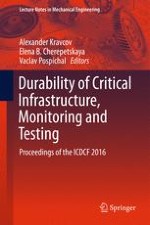2017 | Buch
Durability of Critical Infrastructure, Monitoring and Testing
Proceedings of the ICDCF 2016
herausgegeben von: Alexander Kravcov, Elena B. Cherepetskaya, Vaclav Pospichal
Verlag: Springer Singapore
Buchreihe : Lecture Notes in Mechanical Engineering
